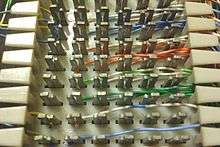66 block
A 66 block is a type of punchdown block used to connect sets of wires in a telephone system. They have been manufactured in three sizes, A, B, and M. A and B have six clips in each row while M has only 4. The A blocks spaced the rows farther apart, and has been obsolete for many years. The B style is used mainly in distribution panels where several destinations (often 1A2 key telephones) need to connect to the same source. The M blocks are often used to connect a single instrument to such a distribution block. 66 blocks are designed to terminate 22 through 26 AWG solid copper wire. The 66 series connecting block, introduced in the Bell System in 1962, was the first terminating device with insulation displacement connector technology. The term 66 block reflects its Western Electric model number.
The 25-pair standard non-split 66 Block contains 50 rows; each row has four (M) or six (B) columns of clips that are electrically bonded. The 25-pair "Split 50" 66 Block is the industry standard for easy termination of voice cabling, and is a standard network termination by telephone companies–generally on commercial properties. Each row contains four (M) or six (B) clips, but the left two (or three) clips are electrically isolated from the right two (or three) clips. Smaller versions also exist with fewer rows for residential use.
66 blocks are available pre-assembled with an RJ-21 female connector that accepts a quick connection to a 25-pair cable with a male end. These connections are typically made between the block and the customer premises equipment (CPE).
Use

Circuit pairs are connected to the block with a punch-down tool by terminating the tip wire on the leftmost slot of one row and ring wire on the leftmost slot of the row beneath the mating tip wire. Typically, a 25-pair cable coming from the phone company is punched down on the left side of the block in pairs. The right hand side of the block is wired to the customer premises equipment with jumper wires. Bridging clips are used to connect the two center terminals, connecting the left-hand side of a split block with its right-hand side, thus completing the circuit. The clips form the point of interface between the subscriber and the provider. The bridging clips can be easily removed by either the subscriber or phone company personnel for trouble isolation, allowing the ability to split a circuit and determine in which direction trouble may exist. An orange insulating cover attached to a 66 block denotes its designation as a demarcation point by the local exchange carrier.
Modern 110 blocks largely supplanted 66 blocks for new commercial installations at the end of the 20th century, as the capability for a circuit to carry digital data overlaid its ability to carry analog voice conversations. 110 block termination is almost always Category 5 (or higher) compliant, and capable of supporting 100 MHz (or faster) signaling. Compared to 110 and higher-density wire terminating blocks, 66 blocks are physically large; and because of their maximum 16 MHz Category 3 signaling compatibility, they are ill-suited for high speed (faster than 10BASE-T) data circuits. However, special Category 5e Certified 66 blocks are available from manufacturers such as Siemon which meet all standards for Cat5e termination.[1]
Split 50 66 blocks are still used as network interface blocks in distribution frames to interconnect circuits with bridging clips, but are primarily limited to narrowband circuits such as POTS/DSL, DS0, or DS1 circuits.